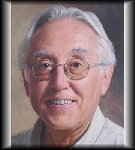Menu

Graham Hawker
Tureck Bach Research Foundation
Trip to Beijing
Calligraphy
Spode Dollar Pattern
Lewis Carroll's Froggy Problem
A New Unit of Time
To see this page in your own language use the following translation bar.

Graham G Hawker was the Managing Director of Metrotel Multi-Media Limited until he retired to Spain. He holds a B.Sc. degree in Mathematics from the University of Liverpool and an M.Sc. in Computer Science from the University of London.
After graduating he joined CEIR, the Management Consultancy subsidiary of British Petroleum, where he developed a combat simulation program for the evaluation of new weapon types.
(It was there that he met Douglas Blacklock, the eccentric UK champion of the artificial language, NEO, invented by Arturo Alfandari. Douglas Blacklock also introduced him to Christopher Hook, the British inventor of the Hydrofin. Blacklock's own invented language, TUNGL, was an influence in Mr Hawker's later philosophical development and was one of the reasons he much later (in 1999) became involved in the Tureck Bach Research Foundation).
Mr Hawker moved in 1970 to the British Oxygen Company (BOC) where he designed and implemented a large mathematical model of their national production and distribution complex. This enabled BOC to make very substantial cost reductions, and became a case study for the Open University. During this time, Mr Hawker studied Corporate Finance at the London Business School and became a Mathematics Tutor for the Open University. His wife, Christine, was one of the first Open University students, studying the Arts.
After a spell in the Airport Innovations Group at British Airports Authority, Mr Hawker joined Grand Metropolitan and became Technical Director of their computer and systems company. He was also a director of two other Grand Metropolitan subsidiaries: the innovative HiTech Electronics Ltd and Marian Electronics.
During this time Mr Hawker was the UK representative on the Diebold Europe Research Program and gave a presentation on the future of computing at their conference in Paris
In 1982 he left Grand Metropolitan to found Metrotel, which specialised in software for public information systems and associated consultancy. Metrotel software and consultancy skills have been used world-wide in the provision of electronic information to the public.
In 1993 he set up a business called CentreVision with Richard Gwynn, who was the director of Gwynn Williams Viewdata at that time. The idea was to install information points in public places such as shopping centres, where the public could search for information on the UK viewdata system (a precursor of the World Wide Web). A photo of the first information point installed in Woking, Surrey, can be seen by clickng here.
In 1993 Metrotel was one of the first companies in the UK to see the potential of the newly created World Wide Web and started creating web sites for UK blue chip companies. Clients included BT, AT&T, St George plc, The Berkeley Group plc, Rank Entertainment, Bass Leisure and Holiday Inns. Metrotel created some of the earliest multi-media web pages for the launch of the Virtual World complex at London's Trocadero Centre.
In 1994, seeing the rapid growth and potential of the World Wide Web, Metrotel started the "Web Monitor Weekly", to give subscribers a weekly summary of new websites of interest. Here are links to PDF copies of:
Mr Hawker also arranged several exhibitions of Japanese Art and Calligraphy in London. Photos of the first exhibition can be seen on "The Calligraphy Festival '93". Another exhibition was of the distinguished calligrapher Mukon Ohmori.
Now living in Marbella, Spain, Mr Hawker maintains an interest in the web as can be seen in his pages at Connected Globe
Hobbies include fencing, walking, and reading as well as simply enjoying life.
Send me an email

© 2019 Graham G Hawker
Privacy Policy